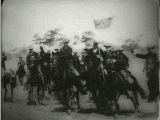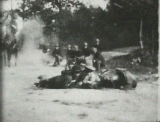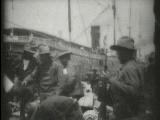Early Cinema and the Spanish-American War
The eagerly anticipated images of the realities of battle--epitomized in an article written by a special war correspondent in the Indianapolis News during the summer of 1898--would never materialize. Indeed, Robert Sklar points out in Movie-Made America that "[f]abrication [became] the point" during the Spanish-American War since "no motion-picture films were made of the fighting in Cuba" (22), largely as a result of technological limitations and the overall conditions of production. During the Spanish-American, new long-range battles (made possible by more accurate artillery and rifle technology as well as the new tactic of individual soldiers firing from under cover) further helped to insure that there would be no motion pictures of land battles of the Spanish-American War. "Though one sees in the press of this period flamboyant notices for war films promising action galore," writes Stephen Bottomore, "in practice because of the new weaponry, most early cameramen couldn't get near enough to film any fighting, and so [were] satisfied with recording 'the human side of war,' showing troop movements, hospital scenes, and so on" (30).
 |
| Roosevelt's Rough Riders |
 |
| Skirmish of Rough Riders |
 |
| Roosevelt's Rough Riders Embarking for Santiago |
In addition to the kinds of military-related subjects mentioned by Bottomore, filmmakers compensated for the lack of "real" war footage from Cuba by faking and staging war films using various methods. The International Film Company photographed a sister ship of the Maine and sold it as an image of the real ship, while Biograph took its previously filmed Battleships "Iowa" and "Massachusetts" and simply renamed it Battleships "Maine" and "Iowa" (Musser, Emergence 241-247). J. Stuart Blackton made tabletop re-enactments with scale model ships in bathtubs (e.g. The Battle of Manila Bay [see Smith and Koury]), while other film companies and filmmakers (e.g., Lubin, Biograph, and Amet) staged their own battle scenes, scale-model naval re-enactments, and scenes of military life.
Edison immediately began filming actualities of Roosevelt's Rough Riders disembarking or charging on horseback toward a stationary camera, and would later stage Rough Rider skirmishes in West Orange, New Jersey (e.g., U.S. Infantry Supported by Rough Riders at El Caney, Skirmish of Rough Riders, Roosevelt's Rough Riders Embarking for Santiago). Finally, the mise-en-scene for one of the biggest hits of 1899, Raising Old Glory Over Morro Castle (widely believed to be a retitled version of what is often referred to as the first American war film, The Tearing Down the Spanish Flag), includes what is clearly a hand-painted backdrop of Morro Castle (most likely painted by J. Stuart Blackton himself).
![]()
[Resisting Spectators] [Works Cited] [Resources]
[American Quarterly]